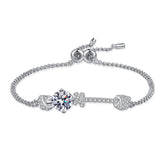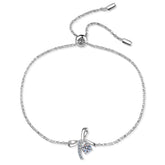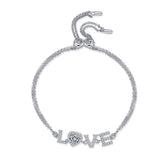About Moissanite
Moissanite is a gemstone born from the stars. It was first discovered in 1893 by a French scientist named Henri Moissan, who later won the Nobel Prize in Chemistry. He discovered microscopic particles of the gem that would eventually bear his name in Arizona, in a crater created by a meteorite that fell to Earth. He initially thought that he had discovered diamonds, but later determined that the crystals were composed of silicon carbide.
Natural moissanite is incredibly rare, so moissanite available today is laboratory-created. After many years of trial and error, the particles Moissan discovered were successfully synthesized to produce what is now one of the world’s most scintillating gemstones.
Moissanite, referred to as a diamond simulant, is engineered to give the illusion of similarity to diamonds, but is compositionally and visually quite different from a real diamond. The durability, brilliance, and color of the two gems are quite distinct. One common property of both diamonds and moissanites is that they are both very good thermal conductors.
Moissanite vs Diamond : A Comprehensive Comparison
When it comes to buying an engagement ring or any other piece of jewelry, diamonds have been the traditional choice for decades.However, with the rise of lab-grown gemstones, moissanite has emerged as a popular and affordable alternative to diamonds. In this article, we will explore the differences between moissanite and diamonds in terms of price, durability, brilliance, quality, sparkle, and lab-grown vs natural.
Price
One of the most significant differences between moissanite and diamonds is the price. While diamonds can cost thousands of dollars, moissanite is a much more affordable option. A 1-carat diamond can cost anywhere from $3,000 to $20,000 or more, depending on its quality and cut. On the other hand, a 1-carat moissanite can cost around $250 to $400, making it an excellent choice for budget-conscious buyers who still demand high quality and value.
Durability
Diamonds are known for their durability and hardness. They score a perfect 10 on the Mohs scale of mineral hardness, making them one of the hardest substances on earth. Moissanite measures 9.25 on the Mohs scale, making it a close second in terms of hardness. The remarkable hardness of Moissanite makes it ideal for daily wear and even as an heirloom piece to be treasured and passed down to future generations.
Brilliance
Brilliance is the way that a gemstone reflects light. Diamonds have been traditionally known for their brilliance, which is a result of their high refractive index. However, moissanite is even more brilliant than diamonds due to its higher refractive index. Moissanite also has a higher dispersion, which means it can reflect more light and create more colorful flashes than diamonds.
Quality
When it comes to quality, diamonds have a well-established grading system based on the "four Cs": cut, clarity, color, and carat weight that has been adopted by many Moissanite sellers, including Moonix. Nearly all of the Moissanites sold by Moonix are colorless, excellent to ideal cut, and VVS or higher clarity, making them comparable to high-quality diamonds.
Sparkle
While diamonds are known for their sparkle, moissanite has a different type of sparkle that is just as impressive.
Moissanite's higher dispersion gives it a rainbow-like sparkle that is unique and eye-catching. It's important to note that the sparkle of a Moissanite or a diamond can vary depending on the cut and quality of the stone, so not all diamonds have the same level of sparkle. The round brilliant cut has the most sparkle, followed by the cushion and oval. The least brilliant cuts are the marquise and pear cuts.
Lab-Grown vs Natural
Another difference between moissanite and diamonds is how they are created. Diamonds are formed naturally deep within the earth, while moissanite is typically created in a lab. Lab-grown diamonds are also available, but are more expensive than moissanite. Some people prefer natural diamonds for their symbolism and rarity, while others appreciate the affordability, value, and ethical considerations of lab-grown and moissanite options.
In conclusion, moissanite and diamonds have their respective advantages and disadvantages, and the choice between them ultimately depends on personal preference, budget, and lifestyle. While diamonds have a long-standing reputation for their quality and beauty, moissanite offers an affordable and equally stunning alternative for those who want the look of a diamond at an incredible value.
Explore- Choosing a selection results in a full page refresh.





